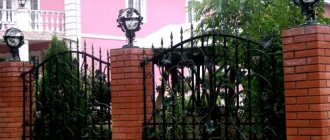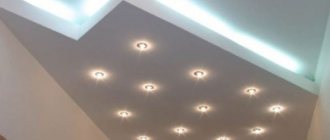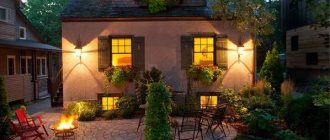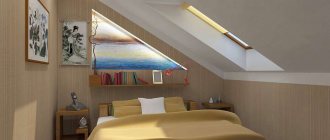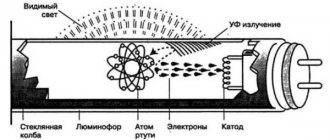Comfortable living of residents in an apartment building is ensured in various ways. One of them is lighting in the entrance. Although many residents continue to use incandescent lamps, alternative lighting sources are growing in popularity as they are more economical, durable and have a low incandescent level.
Requirements for the level and method of controlling illumination of entrances
Entrance lighting can be arranged in an economical way. Innovative bulbs provide soft light that is at the same time more intense and less expensive. This is not done on your own. It is necessary to contact the management company, which is obliged to respond if the lighting does not meet the established requirements.
Currently, many entrances have an automatic system installed. Thanks to this, it significantly reduces electricity costs. This also complies with the requirements established in legislation.
Each apartment building entrance is required to be equipped with lighting fixtures. Regulatory documents indicate what the illumination should be (in lux). The rules do not provide categorical instructions on certain lighting devices.
However, there is an indication that lamps should be economical, with greater light output and service life.
Both fluorescent and LED lamps, including LED strips, meet these conditions.
Lighting of the local area of an apartment building
Organizing good lighting of local areas is a guarantee not only of aesthetic comfort and convenience, but also of safety, since all thieves and robbers prefer to attack in the dark in unlit or poorly lit areas. Also, high-quality and proper lighting of the yard is necessary for safe movement and reducing injuries when people move along the sidewalks of apartment buildings.
To illuminate the local area of any multi-apartment building or structure, the requirements specified in the set of rules SP 52.13330.2011 must be clearly met. This document is an official publication, which states that:
- At the entrance to any apartment building, a lamp must be installed that emits at least 6 lux of illumination.
- Paths and sidewalks for pedestrian movement must be illuminated with at least 4 lux, the same applies to vehicular passage in adjacent areas.
- Territories classified as additional (various outbuildings) must be illuminated with closed-type lamps or floodlights emitting at least 2 lux of luminous flux.
- The yard lamp can be made on the basis of any system, using both incandescent lamps and LED or energy-saving lamps.
If these requirements are not met, citizens living in the building have the legal right to write a complaint to the administration responsible for municipal services or to the city government. There are many hotlines for contacting the city mayor, hotel ministries, or directly to the court. If the entire entrance or house signs the complaint, this will only speed up the solution to the problem.
Lighting standards for various parts of the entrance and utility rooms
Lighting in the entrances of different premises has its own standards and rules (GOSTs, construction SNiPs). The main ones include the following:
- standardization is carried out according to table VSN 59-88, which contains two types of standards: light from incandescent or fluorescent lamps;
- in elevators, lamps have an illumination power of 20 lux (for fluorescent lamps) and 7 lux (for incandescent lamps);
- wheelchair spaces are illuminated with incandescent light bulbs;
- elevator shafts - 5 lux incandescent light bulbs;
- Basements and attics, as well as electrical rooms, garbage collection rooms and others, are illuminated with 10 lux incandescent light bulbs.
Standards for controlling entrance lighting
Automation undergoes regular modernization. Regulatory documentation does not always have time to change in connection with emerging technologies. Therefore, lighting standards in the entrances of residential buildings are often advisory in nature. In this case, you need to remember the following points:
- the automatic system must be turned on and off manually;
- when installing a system that reacts automatically, the light should turn on with different degrees of illumination;
- if sensors are used, then emergency lighting is provided, switched on in the staircases automatically and manually;
- The devices that illuminate the attic are located outside this room.
What is a hallway light with a motion sensor?
The device intended for entrances is no different in principle of operation and purpose from other lamps with motion sensors. The light source itself does not respond to movement within its range. A sensor is responsible for this function, which detects changes in the movement of objects. It also adjusts the lighting at the same time. When a signal is received from the sensor, the lamp can either turn on or off
Before recording changes in movement, the device activates a command on the relay. This could be turning it on or off and even changing the power level. If there is a dimmer, then it becomes possible to adjust the degree of illumination depending on the time of day.
The operation of all components of the device depends on the system options and programs: the light controller, the sensor and the lamp itself. System programs also determine the turn-on delay. The last action can be activated by activating the light bulb after a specified time interval. Thanks to this, you can significantly save energy.
Who pays for lighting in hallways, and how is the amount determined?
Lighting in hallways is a general household need. If previously the consumption of electricity for general household needs was indicated separately in the receipt, then from the beginning of 2021 this item has been removed. Currently, the calculation is performed depending on the presence or absence of a common building meter.
If a common house meter is installed, then the indicators are determined by employees of the supervisory authority together with representatives of the house. After this, the difference between the received amount and the metering values in each apartment is calculated.
The number of square meters not equipped with sensors also matters. The result is distributed among homeowners depending on the area of the room. The more square meters in the apartment, the more you will have to pay for electrical energy according to the ODN.
If there is no meter, then payment is made in accordance with current regulations established in the region.
Advantages of sensors in the entrances of residential buildings
The sensors include sensory light-sensitive elements. They respond to changes in light intensity, lack of light or other external factors. The following sensor can be installed in entrance lighting devices:
- passive operation - infrared; it reacts to the appearance of sound or thermal radiation in the work area;
- active action - ultrasonic, microwave, combined; they produce waves of a certain frequency that are capable of detecting and identifying an object or obstacle.
- The preferred mode of operation of the lighting device and its operating conditions will determine the type of sensor with which it is equipped.
What types of motion sensors are there for entrances?
Motion sensors monitor movements and active movements within their coverage area (usually up to 15 meters). They process the information they receive and send signals to turn off or turn on lighting fixtures.
Depending on the configuration and features of the work, there are:
- motion sensor in the entrance;
- installed in lighting fixtures illuminating the local area;
- sensors as part of security systems.
Operating principle of light sensors
Light sensors (photo relays, photo sensors) are also called twilight sensors. They respond to changes in the brightness of natural light flux. Sensors of this type are in great demand in the autumn-winter period, in the off-season.
Combined
This type of sensor combines several tracking technologies, such as microwave and IR. Their parallel operation makes it possible to detect and recognize movement in the work area with great accuracy. Unlike light sensors, they monitor movements around the clock. In addition, combined sensors are capable of monitoring electrical equipment located in the entrance.
Who replaces lighting in hallways?
If there is no light in the entrance, then the reason can be determined independently. It could be as follows:
- light bulb burnout;
- lamp malfunction;
- short circuit;
- damage to switches;
- breakdown of the distribution board;
- accident;
- planned work.
After determining the cause of the breakdown, the management company or homeowners association is reported. These organizations are responsible for providing light in the entrances of an apartment building (the responsibility does not apply to balconies, the decision on lighting of which is made by homeowners).
Expert opinion
Mironova Anna Sergeevna
Generalist lawyer. Specializes in family issues, civil, criminal and housing law
Replacement of light bulbs is the responsibility of the management company. Troubleshooting and replacement are carried out based on the results of routine inspections. They are carried out according to a set schedule.
Request to the management company for replacement of lamps in the entrance
Every respectable person must pay taxes, which include utilities. And payment for the technical equipment of an apartment building is included in the column “General building services”. So, if a person decides to pay for household services, then at the same time he pays for the light in the entrance. There are several cases, if the lamps on the site burn out or the lights do not light for other reasons, then the money is still credited. Here the tenant must either call and contact special services so that the entire organization is on them, or call the neighbor, whose turn it is to screw in the light bulbs. Provided that the neighbors of the house agreed to do so. In the twenty-first century, the vast majority of people live in an apartment building. This is convenient, since high-rise buildings save space for buildings. Living in an apartment is quite comfortable and many people choose it. However, with all the visible advantages, there are also disadvantages. Due to the presence of property that is located in a public space - an entrance, many residents often have the question of who changes the light bulbs in the entrance.
We recommend reading: At what age does a child have a bus ticket?
Regulatory acts of Russian legislation in the field of housing and communal services, including the Housing Code of the Russian Federation and the Rules and Standards for the Technical Operation of the Housing Stock, do not provide for the need to hold a general meeting of owners of an apartment building and to carry out work on the maintenance of the common property of the owners of an apartment building and determine the volume financing of these works. The opposite interpretation of the laws - “until the general meeting of homeowners votes with the required number of votes on the need for any service and it becomes a condition of the contract with corresponding additional financing at the expense of homeowners, the management company is not obliged to provide such a service,” was recognized by the Presidium of the Supreme Arbitration Court of the Russian Federation as incorrect.
What are the possible consequences for the management company if there is no lighting in the entrances?
Lighting in the entrance is very important, because in addition to its direct purpose, it provides the safety of residents and protection against theft. Therefore, authorized organizations are required to promptly respond to these applications.
If after 7 days after filing the application the problem is not resolved, the management company may be held legally liable under the Code of Administrative Offenses. In accordance with Article 7.22 of the Code, officials are subject to a fine of 4 to 5 thousand rubles. And the fine for legal entities ranges from 40 to 50 thousand rubles.
The rights and legitimate interests of citizens are controlled by the state housing inspection. Specialists of this organization and administration have the right to draw up protocols if relevant violations are identified.
Selection of lamps for entrances of apartment buildings
Lighting in the entrance of an apartment building is the key to the comfort of residents. Today, the entrances of multi-storey buildings, especially if the building has an elevator, often do not have windows, which does not allow movement along them without additional light sources. Therefore, a special role is played by the quality of lighting, its compliance with all SanPiN requirements, efficiency and safety.
Requirements for lighting in the entrance
One of the main documents regulating lighting in entrances is SNiP 23-05-95.
Staircases are divided into main and auxiliary.
- According to SNiP, the illumination of the main staircases should be 100 lux, and the illumination of auxiliary stairs can be only 50 lux.
- In addition to stairs, almost any entrance has corridors and passages. The main corridors must have an illumination of at least 75 lux; for auxiliary rooms - passages, this standard can be reduced to 50 lux.
- For elevator halls, the standard illumination level is 75 lux.
- For lobbies, strollers, bicycles and halls, the standard is 150 lux.
- For utility rooms, this norm is 75 lux.
It is worth noting that there is a standard SP 31-110-2003. For all specified rooms, he normalizes illumination to “not lower than 20 lux,” and these can be lighting devices of any kind and type.
Using incandescent lamps
Most often, due to cost efficiency, the Developer, and then the Management Company, organizes lighting systems in the entrances using NPP type lamps and conventional incandescent lamps.
And this is not the best solution, because... Incandescent lamps often cause fires as a result of overheating (the heating of the element reaches 360 degrees Celsius). As a result of operation and vandalism, lampshades are broken, and in violation of established standards, lamps operate open, which doubles the risk of fire hazard.
A lamp without a special light diffuser distributes light unevenly, which makes the lighting poor quality.
The power of such lamps usually does not exceed 60 Watts, but the energy consumption of incandescent lamps is several times higher than the cost of maintaining LED lamps, and the cost of using outdated light sources falls on the residents of an apartment building.
Also worth noting among the minuses is the small number of hours (about 1000 hours) that an incandescent lamp lasts.
Fluorescent lamps are more durable, lasting up to 25 thousand hours, but their production using mercury vapor, which is a poisonous substance, makes them less and less popular.
LED lights
Due to the fact that the legislation of the Russian Federation is moving towards mandatory saving of resources, and due to the reluctance of owners to incur high costs for maintaining the lighting system in entrances, an increasing number of houses are switching to LED lighting.
At the moment, already at the construction stage, lamps using LED light sources are being added to the project.
The cost of electricity is so insignificant that it completely covers the cost of installing LED lamps/luminaires throughout the year.
Among the advantages, it should be noted that the light from LED sources does not irritate the eyes, the lamps are fireproof; they do not heat up and do not emit toxic fumes, and do not require special disposal conditions.
And if the lamp has a built-in motion sensor, then this allows us to reduce electricity costs several times.
Replacing lighting
Replacing the lighting in the entrance is a planned job that may be required for the following reasons:
- lamp burnout;
- short circuits and electrical wiring faults;
- mechanical damage to the lampshade or the lighting fixture itself, interfering with the safe performance of its functions.
No one can forbid the owner to change the light bulb in the entrance himself or even remove the lamp to install a new one, but it is worth remembering that in the absence of special skills and knowledge this can be dangerous and you may have to bear the cost of the light bulb or a new lamp. It is better to contact a management company or HOA, then the work will be done efficiently and reliably, but most likely in a long time.
What are the possible consequences for the management company if there is no lighting in the entrances?
Even if the light bulb in the lampshade just burned out, you need to leave a request by phone, in person, or write an application addressed to the management company of your home.
According to legal requirements, the problem must be resolved within the next calendar day. If the application is ignored, this is the reason for contacting law enforcement agencies, primarily the prosecutor's office - or the housing inspection.
Even if a dissatisfied owner appeals to higher authorities, the Management Company must solve the problem no later than 7 calendar days from the date of receipt of the first appeal.
Sanctions may be applied to the management company: officials are subject to a fine of 4 to 5 thousand rubles, and legal entities, primarily the management company itself, are subject to a fine of 40 to 50 thousand rubles.
High-quality lighting in the entrance is the key to the comfort of residents, so you should be more vigilant about it, and not be afraid to insist on installing high-quality and economical lamps.
Recommendation from NOVOLAMPA
The optimal solution for housing and communal services is the bestseller from GENILED
LED LAMP GENILED PUBLIC SMART 15W
1.
It should be noted that in 2021 this lamp became
the Winner of the “Golden Photon” award in the “Product of the Year” category
in the “LED lamps for housing and communal services in the NPP/NPD category.”
We have already mentioned this type of lamp above, let us decipher the abbreviation: H - the light source is an incandescent light bulb; P - ceiling mounting type; P - suitable for installation inside industrial premises.
2.
These lamps have a wide range of applications:
they are often installed to illuminate workshops, warehouses, technical rooms of apartment buildings, adjacent areas of industrial buildings, corridors and auxiliary exits, baths and saunas, entrances of high-rise buildings.
3.
The lamp attracts the attention of many architects in connection with modern design.
Unlike outdated design lamps of the NPP / NPD type with an E27 base for incandescent lamps, the GENILED PUBLIC SMART 15W lamp fully fits into the concept of the modern Streamline
.
The name itself (streamline - “flow line”) comes from a term from the field of aerodynamics. Streamline modern
style is influenced by industrial stamping and aerodynamic technologies.
4.
The ergonomic modern form fully reflects the internal content of the lamp: simplicity, efficiency, convenience.
5. Lamp body
made of heat-conducting plastic with a sealing silicone gasket and a sealed lead-in for reliable protection from moisture and dust.
All this provides a high level of protection - IP 65
(note that many lamps of this type for incandescent lamps have protection - only IP 54)
6.
72 bright CMD LEDs with a luminous flux of up to 1350 lm allow you to meet the required
level of illumination and energy efficiency
.
7.
SNiP normalizes the temperature of light in entrances - from 4000 to 7000K, therefore the GENILED PUBLIC SMART 15W lamp has
an optimal color temperature - 4200K
.
8.
A high-quality switching
power supply with protection against short circuits
, voltage surges, overcurrent and maximum temperature ensures a long and bright life for LEDs.
9.
The Smart microwave motion sensor
detects a person even behind a door or a thin wall within a radius of up to 8 meters. The lamp has 2 modes:
1. 20%-100% - The lamp turns on to maximum if it detects your presence, but as soon as you leave the room, the lamp gradually goes out and goes into standby lighting mode - at 20% of the possible brightness.
2. 0%-100% - The lamp turns on to maximum if it detects your presence within a radius of 8 m, but as soon as you leave the room, the lamp goes out after 45 s.
Systems with motion sensors are considered the most optimal and economical - they turn on the lights only when they react to someone’s presence. Systems with motion sensors are easy to connect, but allow you to effectively save energy and allow even small children or, for example, residents with heavy bags, mothers with strollers, etc. to walk along the illuminated entrance.
10.
Matte diffuser
made of lighting polycarbonate is fireproof and ultra-durable.
11.
The anti-vandal system
is well thought out , because The design of the device is as simple as possible, which eliminates the need to use a screw during assembly. 4 clips rest against the wall and do not allow you to remove the diffuser. And the Security Torx screw, which is used to attach the lamp to the wall, can only be unscrewed with a special attachment that comes with the kit.
12.
The lamp is reliably protected from overvoltage and overheating, as well as
from low temperatures
. Specialists from the Chelyabinsk Radio testing center have officially confirmed that GENILED PUBLIC SMART 15W lamps can operate at -45°C
13.
This series also includes luminaires
without a motion sensor
LED luminaire Geniled Public mini 6W 4200 K
LED lamp Geniled Public 15W 4200 K
And if you, as the owners, at a general house meeting decide to change the lighting system, replace the lamps with LED ones, our specialists will be able to help you with the selection of products. We guarantee you a wide selection of lighting devices that are reliable, high quality and affordable. Call 8 (800) 700-80-91, comfortable lighting is possible!
Automation schemes for entrance lighting
Lighting in the entrances of apartment buildings is carried out in different ways. Each scheme has its own characteristics. They can combine each other or have similar characteristics. Below are the options that are most common.
Lighting control using push-button stations
The method is more suitable for low-rise buildings, whose residents have a conscientious attitude. With its help it is possible to save money, but this depends only on the residents. The main advantage of this method is its affordable price.
Management is carried out in two ways.
The first one is a push-button post located in the entrance hall and on each floor.
The second one makes it possible to turn the light on and off only at the stairwell. Basements and attics have external lighting in the form of a standard switch or a special sensor.
If apartment owners do not show awareness in general house issues, then the lights can be turned off using a timer.
Using Light Sensors
If there is good natural light, using a system with light sensors is a suitable option. This is not the most economical option, but is used as an alternative to a standard switch.
The sensor is installed in a dark place. The device works when it gets dark. In this case, the lighting can be turned on in the entrance or outside the room. In utility rooms, it is advisable to use standard switches.
Using motion sensors
This scheme arose not so long ago, but its popularity is growing every year. When using motion sensors, savings are achieved. Moreover, no attention is required from the residents.
In this case, sensors are installed on each floor, but sometimes - one at the entrance to the entrance. After the device is triggered, the time until shutdown is counted. If there is an elevator, the lights are turned on differently. Most often, the sensor is triggered when leaving the elevator. It is better to equip the utility rooms of the entrance with standard switches.
Lighting of the entrance area in front of the elevator.
- If the house has an elevator, then a sensor at the entrance to the entrance is required. It should be in contact with the lighting lamp, which will illuminate the area in front of the elevator. Further switching on of the lighting will depend on the characteristics of the particular entrance, as well as the scheme chosen by the residents.
- In order to automate lighting in a stairwell with an elevator, it is necessary to integrate with the elevator system. If the circuit is developed and the devices are connected correctly, then when you press the button for the selected floor, in addition to the command for the elevator, a pulse will also be sent to the sensor of its stopping platform. Implementing such a scheme is quite difficult. An alternative would be to link the lighting system to the door opening switch. However, all work related to the elevator must be carried out by specialists.
- The simplest and most affordable option is to trigger a motion sensor when a person exits the elevator. In this case, there is one drawback - you will have to exit the elevator into the darkness of the landing. However, all other options have certain difficulties.
When using motion sensors, the lighting of the entrance from the street, as well as the basement, attic and other utility rooms, will have to be equipped with a manual control system. This method will be discussed in more detail below.
Acoustic relays are an alternative to motion sensors. They are triggered, for example, by the sound of footsteps, a closing door, clap, conversation, or even voice commands. However, will such a system work correctly in a very noisy entrance? Will she react by turning on the lights on the landings to the noise of the erupting family scandal? To the sounds of a working instrument, loud music in one of the apartments, etc.? In any case, practice shows that the demand for such entrance acoustic systems is still lower than for those equipped with motion sensors.
Light sensor system
The system using light sensors is designed for the influence of natural light on them. It is clear that it is suitable for entrances whose flights of stairs are equipped with windows. The photo relay is activated and closes the lighting system circuit only when natural light decreases below a preset threshold. That is, with the onset of twilight. A similar system is usually used, say, for automatic control of street lighting.
